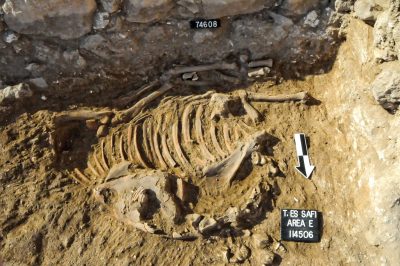
 An international team of archaeologists has uncovered the earliest example of the use of a bridle bit with an equid (former species of the horse family) in the Near East. The discovery provides first evidence of the use of the bit to control an animal long before the appearance of the species of horse known today in the Near East.
An international team of archaeologists has uncovered the earliest example of the use of a bridle bit with an equid (former species of the horse family) in the Near East. The discovery provides first evidence of the use of the bit to control an animal long before the appearance of the species of horse known today in the Near East.
Evidence of the bridle bit was derived from the skeleton of an ancient donkey dating to the Early Bronze Age III (approximately 2700 BC), found at the excavations of the biblical city of Gath (modern Tell es-Safi) of the Philistines—the home of Goliath—located in central Israel. The donkey was laid as a sacrificial offering before the construction of a house in a domestic neighborhood.
“This is significant because it demonstrates how early domestic donkeys were controlled, and adds substantially to our knowledge of the history of the donkey (Equus asinus) domestication and evolution of riding and equestrian technology. It is also significant that it was discovered on the remains of an early domestic donkey that was sacrificed probably as an offering to protect what we interpret to be a merchant domestic residence uncovered during our excavations,” explained Professor Haskel Greenfield of the University of Manitoba.
“The use of a bridle bit on a donkey during this period is surprising, since it was commonly assumed that donkeys were controlled with nose rings, as depicted in Mesopotamian art,” said Professor Aren Maeir from Bar-Ilan University.
The authors propose that the wear on the tooth of the donkey was made with a soft bit, likely made from rope or wood. “Only later, from the Middle Bronze Age and onward (after 2000 BC), was it thought that bits, in particular metal bits, were used—first with horses that were introduced to the Near East at the time, and subsequently with other equids, such as donkeys,” Maeir added.
Based on isotopic analyses, there is evidence that this donkey was born in Egypt and brought to Canaan in the last few months of its life before it was sacrificed and buried beneath the floor of the house. Domestic horses were not present in the Near East at that time. As a result, donkeys were not only used as beasts of burden, but were also ridden by the newly emerging elites in these early city-states.
Source: Excerpt from an article by Edgar Asher, Ashernet
Photo Credit: Ashernet
All logos and trademarks in this site are property of their respective owner. All other materials are property of Bridges for Peace. Copyright © 2025.
Website Site Design by J-Town Internet Services Ltd. - Based in Jerusalem and Serving the World.